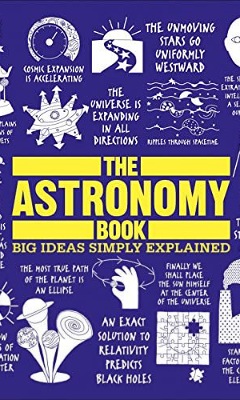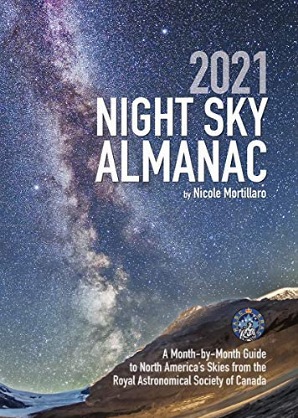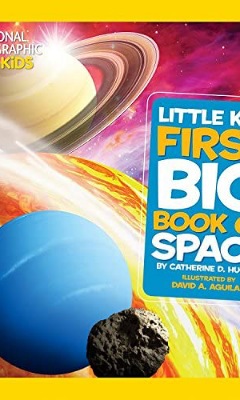A good astronomy book is one of the essentials for starting out as a stargazer or a visual astronomer. It will open your eyes to the wonders of the night sky so you know what you’re looking at whenever you take out your telescope for a stargazing session. Without theoretical knowledge of the night sky, you will only see a maze of white lights.
Below is a list of the best astronomy books for beginners. Written with new stargazers in mind, they are easy to read and understand and designed to guide you on what to look at, when to look, where to look, and how best to study the night sky. Whether you’re the newest amateur astronomer on the block, a casual stargazer or enrolled in a first year astronomy course, there’s something for you on the list.
Disclosure: This article includes affiliate links that may provide a commission to me at no cost to you if you make a purchase through those links.
Table of Contents
Which Book is Best for Astronomy Beginners?
Best Overall: Night Watch: Night Watch: A Practical Guide to Viewing the Universe

Overview
The Night Watch: A Practical Guide to Viewing the Universe is the absolute best book for beginners in stargazing and amateur astronomy. All the information you need to get started looking at the night sky is covered.
It will show you what’s out there and how to best see it, contains sky patterns for both the northern and southern hemisphere, touches on astro-photography and how to use binoculars and telescopes and features future solar and lunar eclipses, and planetary locations and conjunctions updated through 2025.
Author: Terence Dickinson
Pros
- Best selling and top rated astronomy book for backyard astronomers
- Written in an engaging and easy to follow manner
- Illustrated with beautiful photographs
- Contains cosmic events such as eclipses updated up to 2025
Cons
- Does not go in depth on telescopes and equipment
Pricing
Bottom Line
The Night Watch is the top selling astronomy book for beginners for good reason. It’s an excellent introductory book for anyone new to stargazing, constellations, and telescopes.
Best for Absolute Novices: Astronomy For Dummies

Overview
This list of the best astronomy books for beginners wouldn’t be complete without the Astronomy For Dummies guide. Geared towards novices in the science of space, it offers an easy to follow introduction to astronomy.
It covers all the bases from the solar system and planets to the stars, comets, meteor showers, asteroids, galaxies, nebulae, black holes, dark matter, search for extraterrestrial intelligence, and the Big Bang.
Author: Stephen P. Maran
Pros
- Easy-to-understand guide to space
- Humorous with dry wit and puns
- Steers clear of complicated jargon
- Contains updated star maps, charts, and eclipse schedules
- Includes an insert with full-color photographs
- Covers recent discoveries in space
Cons
- Leans more towards the science of astronomy rather than stargazing
Pricing
Bottom Line
You can’t go wrong with the Astronomy for Dummies as your first book on astronomy. It’s comprehensive, well-written, and easy to follow when you’re completely new to the subject.
Best for Stargazing: Turn Left At Orion: Hundreds of Night Sky Objects to See in a Home Telescope – and How to Find Them

Overview
If you already have a set of binoculars or a beginner telescope and wondering what to look at, Turn Left At Orion is the astronomy book for you. It will tell you what things you can see, how to find them, and what you can expect to see with a large or small telescope. You will even get advice on how to choose the filters to use.
Designed to be used right along a set of binoculars or a small telescope, it has large pages and is spiral bound for ease of use in the field.
Author: Guy Consolmagno and Dan M. Davis
Pros
- Highly recommended by other astronomers
- Detailed guides of the moon, planets, and deep sky objects
- Designed to be used in the field when observing the night sky
- Shows you the kind of sights you will see through a small telescope
- Organized by seasons making it easy to navigate through
- Provides interesting tidbits of information
Cons
- Only shows what the small telescopes show
Pricing
Bottom Line
Turn Left At Orion is a must own astronomy book. Not only will it prove an indispensable companion as you’re getting started in observational astronomy, it will also come in handy as a reference book once you’re a seasoned amateur astronomer.
Best on Space and Time: Astrophysics for People in a Hurry

Overview
Are you curious about the nature of space and time? Astrophysics for People in a Hurry will answer all your questions without overwhelming you with complex explanations. It covers the interesting, informative, and important stuff you would want to know about the cosmos.
Learn about the big bang, black holes, quarks, quantum mechanics, the search for life in the universe, dark matter, dark energy, and more in an easy going manner. The chapters are short and succinct so you can read it quickly. The last section on Reflections on the Cosmic Perspective is especially thought provoking.
Author: Neil deGrasse Tyson.
Pros
- Educates about the cosmos without being overwhelming
- A short overview that’s informative yet easy to read
- Written in a down to earth way
- Short, easy to follow chapters
- Written with verve, wit, and enthusiasm
- A light read you can finish quickly
Cons
- Designed to be a short overview, some might find it lacking in details
Pricing
Bottom Line
Would you like to delve deep into the complex realm of astrophysics without getting lost in the details? Astrophysics for People in a Hurry is a great book to immerse yourself in. Not only will it enlighten you, it will leave you feeling part of something incredibly grand.
Best for Astronomy Class: Astronomy: Astronomy: A Beginner’s Guide to the Universe

Overview
Designed as an introductory textbook for an astronomy class, Astronomy: A Beginner’s Guide to the Universe is one of the best books on astronomy whether you’re studying astronomy or just looking for a solid foundation upon which to build your hobby as an amateur astronomer.
It features the latest discoveries as revealed by recent space missions so you will gain up to date knowledge. Last but certainly not least, it’s illustrated with vibrant colors pictures that aid in understanding the content and also make the book captivating.
Authors: Eric Chaisson and Steve McMillan
Pros
- An introductory book with reader oriented language
- Best for a first astronomy class
- Features the latest development in the field
- Fascinating color pictures make it an engaging read
Cons
- The quality of the paperback version is not up to standard, especially given that this is one of the most expensive astronomy books.
Pricing
Bottom Line
A fantastic book for any beginner in astronomy. You can read it casually or use it as a textbook for a astronomy class.
Best Comprehensive: Astronomy: Astronomy: A Self-Teaching Guide

Overview
Lively and stimulating, Astronomy: A Self-Teaching Guide is one of the most enjoyable astronomy books for new stargazers and amateur astronomers. It presents all the information you need in a lively manner that will have you totally engrossed.
Written in an approachable and easy to grasp style, it will help you understand the night sky events and phenomena including stars, planets, galaxies, black holes, the Big Bang, and life in space. Best of all, the book is updated to reflect the latest discoveries.
Author: Dinah L. Moché
Pros
- Comprehensive course in the theory of astronomy
- Up to date with contemporary discoveries
- A self-teaching format with interactive exercises
- Everything is well explained and illustrated with graphics
- Orderly presentation and stimulating content
Cons
- The exercises require basic scientific skills
Pricing
Bottom Line
If you’re just getting started in astronomy as a hobby and want to delve deeper into the field, Astronomy: A Self Teaching Guide is the best way to satisfy your curiosity. You will love it especially if you prefer an active learning style.
Best on History of Astronomy: The Astronomy Book: Big Ideas Simply Explained

Overview
The Astronomy Book: Big Ideas Simply Explained explains hard to grasp ideas about space, time, and astrophysics clearly and simply. Whether you’re curious about black holes and dark matter or looking to learn more about the cosmic expansion, this book is sure to take your understanding of the universe to the next level.
It goes all the way to the violent birth of the universe to the modern day astronomy to the future. It features iconic astronomers, ancient beliefs, and also delves into the latest scientific theories. All the concepts are illustrated with flowcharts and graphics and explained in simple English.
Author: Dorling Kindersley Ltd (DK)
Pros
- Written in an easy to read jargon-free language
- Great book for understanding the history of astronomy
- Engaging book you will not want to put down
- Comprehensive without being overwhelming
- Makes a great reference book
- Best for young adults and teens
- Visual layout with illustrations, pull quotes, and simple mind maps
Cons
- Leans more on the history of astronomy and famous astronomers
- Kids might find some of the concepts hard to grasp on their own
Pricing
Bottom Line
Great for kids and adults that want to understand the journey to our modern understanding of Astronomy and Astrophysics
Best Astronomical Almanac: 2021 Night Sky Almanac: A Month-by-Month Guide to North America’s Skies from the Royal Astronomical Society of Canada

Overview
The 2021 Night Sky Almanac from the Royal Astronomical Society of Canada is the best night sky almanac for someone new to astronomy. This is because it’s a concise book presented in a visual manner. It will tell you what’s interesting in the North American night sky in 2021 so you can plan your observation accordingly.
It starts with a general introduction of the objects – the planets, stars, comets, to globular clusters. It then goes over the cosmic events to look out for each month in 2021, complete with sky maps, star charts, and moon phase charts. It also contains information on constellations, measurements, and instruments.
Pros
- Makes a great book for reference
- High-quality semi gloss paper and binding
- Provides a great introduction to astronomy
- Compact size, great for use outside
- Amazing color photos and graphics
Cons
- Only offers guidance to the North American sky – the US and Canada
Pricing
Bottom Line
The 2021 Night Sky Almanac is a must have for anyone starting to study the night sky in 2021. It’s beginner friendly and will guide you on the interesting things to stay on the lookout for.
Best Telescope Book: 50 Things To See With A Small Telescope

Overview
As a beginner getting started with a small telescope, 50 Things To See With A Small Telescope has a list of the planets, stars, galaxies and nebulae you can see right from your own backyard! The 50 things include Venus, Mars, Jupiter, Orion Nebula, The Milky Way, Andromeda Galaxy, Crab Nebula, Comets, asteroids, the International Space Station, globular clusters, and more.
You will also see what these objects look like through a small telescope. The book also covers how to choose your first telescope and how to star hop to the objects you wish to observe using the prominent constellations as a guide.
Pros
- Simple and concise presentation
- Star maps and eclipse charts for up to the year 2030
- Quick go-to reference book
- Simple and fun to read
Cons
- Extremely basic book – does not offer much detail on the targets
Pricing
Bottom Line
A must have for an adult or child starting their stargazing journey with a small telescope.
Best for Kids: National Geographic Little Kids First Big Book of Space

Overview
National Geographic Little Kids First Big Book of Space is a fantastic way to introduce young children to the wonders of space. It’s engaging, vibrant, and written in a kids friendly language.
It explains space objects such as planets, steroids, comets, nebulas, stars, galaxies, and more in a way kids can understand. It features short chunks of text illustrated with stunning images. The book is large which is ideal for developing fine motor skills.
Author: Catherine D. Hughes
Pros
- Vibrant photographs and graphics
- Big book that little hands can turn
- Short chunks of text children can grasp
- Visually attractive and well organized
- Easy to read and understand
Cons
- Flimsy in quality – pages tend to detach from the spine with time
Pricing
Bottom Line
If your child is interested in space, the Little Kids First Big Book of Space by National Geographic will satisfy their curiosity. It’s also a great book to cultivate a toddlers interest in astronomy. It’s great for preschoolers and early elementary level kids.
How Do I Start Learning Astronomy?
Astronomy is best learnt through a combination of reading and hands on observation of the heavens. Reading informs what to look at and also explains what you see. Observing gives you a hands on experience of what you learn in books.
What Should I Read for Astronomy as a Beginner?
The best astronomy book to read as a beginner should cover the basics of astronomy in a simple and easy to understand manner. It should offer tips on what you can see in the night sky, how to locate what you want to see, and how to best observe celestial objects.
Beyond equipping you with the basic theoretical and practical knowledge of the night sky, a good book on space should get you excited to get out and study the night sky and pique your interest to learn more about the universe.
That’s a Wrap!
The best way to start your study of the heavens is with a great astronomy book as your guide to the night sky. Reading such a book will change your view of the sky forever.
The best astronomy books for beginners reviewed here will deepen your appreciation of astronomy, and fuel your desire to learn more about the universe! Simply pick the best one for your interest and delve right into the universe.

